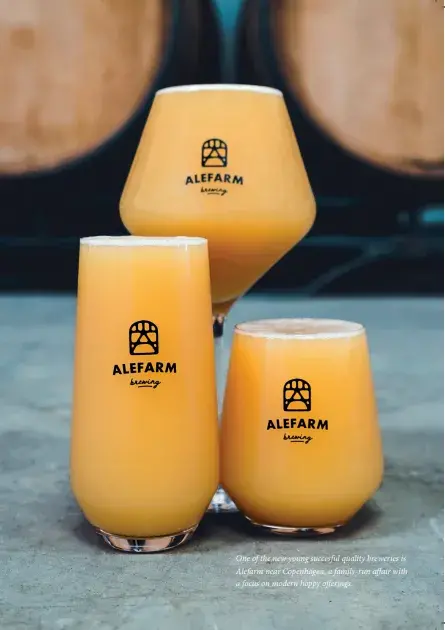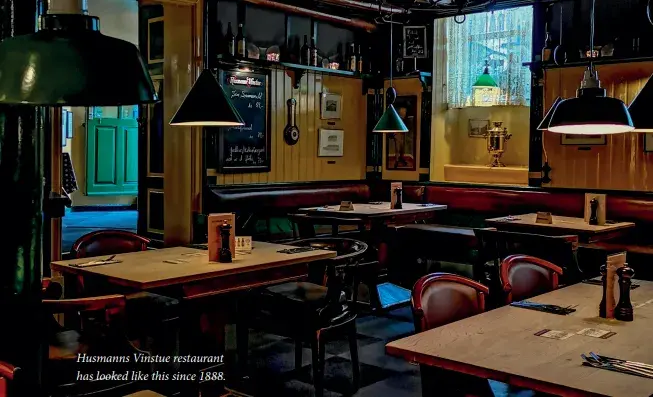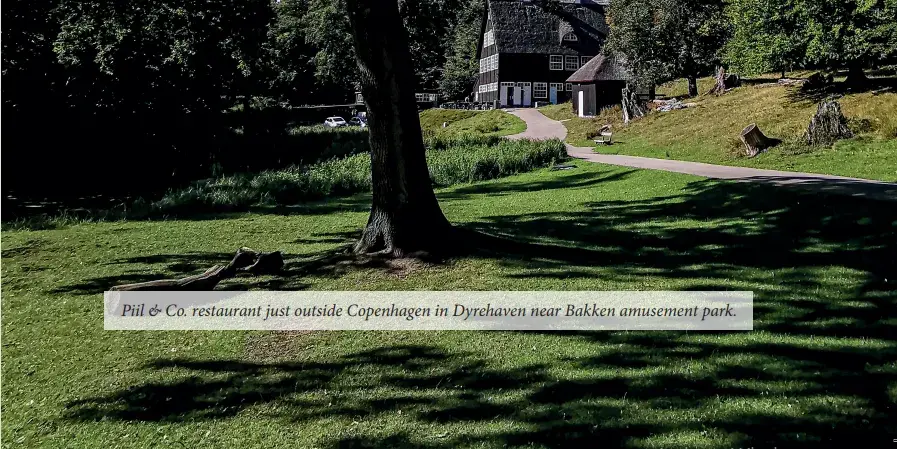Danes have been making and drinking beer for more than 3,500 years, and it has always been the preferred drink with smørrebrød. For centuries, beer was brewed on every farm. Later, it was brewed in hundreds of breweries
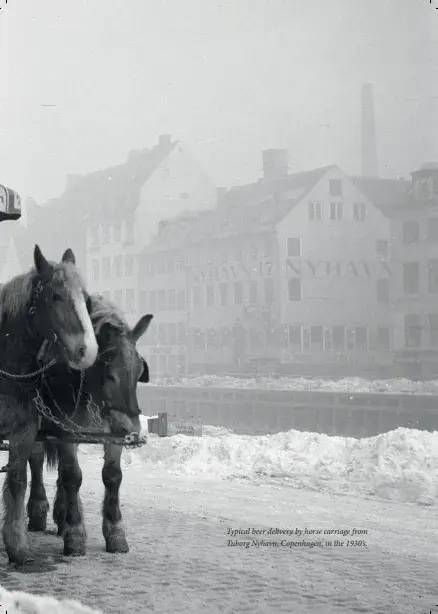

You can call beer ‘liquid bread’ because both beer and bread stem from a mash of grain. If leavened, it can be transformed into bread by baking in heat. If fermented, it can be transformed into beer. In Danish food culture, smørrebrød and beer have always gone hand in hand.
With the discovery of an ancient bucket containing remnants from wheat beer, archaeologists have evidence of beer being brewed in Denmark since at least the year 1370 BC. Every farm in the olden days baked its own bread and made its own sausage, and the brewing of beer on individual farms was just as commonplace.
If you visit a Danish home today, you will often find a room called the bryggers where things like washing machines, brooms, and boots are kept. In the olden times, this room was where the beer – known as brygget – was brewed; therefore, the room was called a bryggers.
In the 1800s, small professional breweries emerged all over the country to supply this very important part of the Danish diet that was consumed by both young and old. Well water was often contaminated in those days, so it was safer to drink beer. Adults were known to consume several litres of beer daily. It should be noted that the alcohol level of the beverage was no more than 2-3%.
The quality of beer fluctuated due to a very limited understanding of the yeast and microbiological processes involved in the brewing process, a problem the French scientist Louis Pasteur helped shed light on. He discovered that it was often bacteria that spoiled the beer, and he suggested treating the beer with heat – or ‘pasteurising’ it – in order to kill microorganisms. This was a a precursor of a later discovery: in 1883, a scientist at the laboratory at Carlsberg Breweries, Emil Christian Hansen, discovered that wild yeast could also spoil beer the same
Tuborg Brewery was the first to introduce pilsner beer in Denmark, and their commercial poster ‘Tuborg man,’ from the year 1900, became an iconic symbol for beer
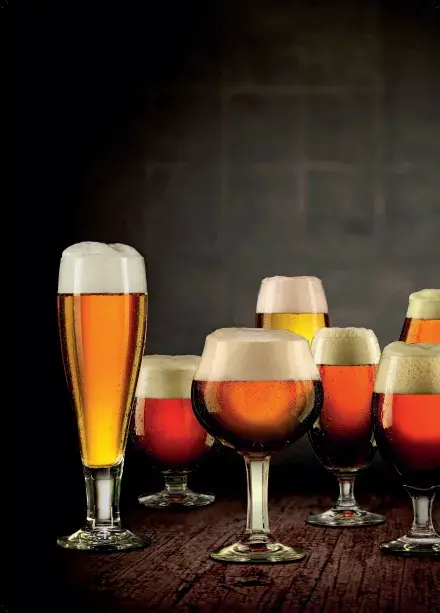
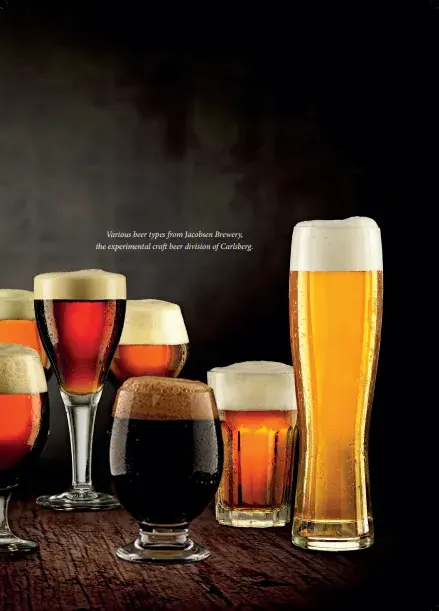
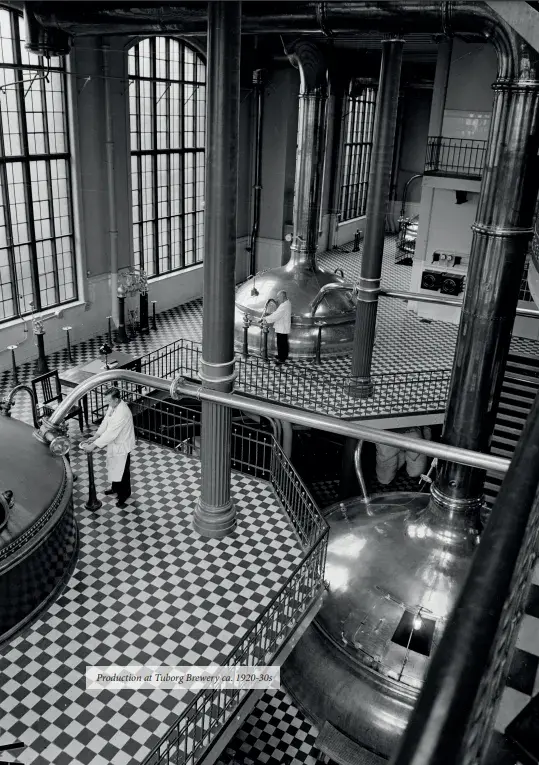
way that bateria did. He developed a method to purify yeast for better fermentation. This paved the way for a brand-new method of brewing beer, and the newly discovered yeast strain, Saccharomyces carlsbergensis, was offered freely to other breweries for their use. Since then, S. carlsbergensis – known today as S. pastorianus – became the dominant pilsner yeast among the hundreds of competing Danish breweries as well as among thousands of breweries around the world.
Carlsberg beer became world-famous and, in the 1900s, gradually evolved into being the dominant player in the Danish beer industry eventually absorbing its long-standing rival, Tuborg Breweries. Carlsberg’s near-monopoly in Denmark meant that, during the years 1970-2000, most Danes drank the same type of beer, a light pilsner.
In the new millennium however things started to change. The first sign of change was seen as early as 1990, when the steakhouse chain Hereford Beefstouw in Copenhagen established the Apollo Brewpub. At that point, there were no revolutionary recipes or ingredients in play at the brewpub, but the beer there was hand crafted and different in style from the mass-market beers known to Danes. Apart from a small percentage of beer drinkers who enjoyed the few and often strong speciality beers, the pilsner ruled the Danish beer world. Whether it was brewed by the big players Carlsberg or Tuborg, or by some of the regional breweries in the larger towns of Denmark, it would taste more or less as identical: much like a Big Mac does at any McDonald’s burger outlet around the world.
But something was brewing in those years, and in 1995, when Denmark’s first dedicated microbrewery, Brøckhouse, was founded. Carlsberg Breweries took notice, so in 1997, the brewery experimented with a special lager, Carl’s Special, to mark the brewery’s 150th birthday.
‘It started very much as a grassroots movement within the brewery,’ explains Head Brewer Morten Ibsen, who joined Carlsberg in 1996 and today heads the craft beer division, Jacobsen Brewery situated in the old original buildings of Carlsberg.
‘A few young brewers met with some marketing people, and together, they created the new Semper Ardens series which broke with tradition. In those years, you could often buy an entire case of pilsner with 30 bottles for 100 kr. (circa 14 USD), but if you wanted a bottle of Semper Ardens, you had to pay 50 kr. for 70 cl. The older brewers did not get it. They found it crazy to start brewing types of beer we were not known for. Also, the top management was not convinced that it would be possible to sell beer at this price, but the consumers received it well. This way Carlsberg actually helped change the perception of beer and price, which I think helped make way for the many microbreweries spawned in the 00s,’ says Morten Ibsen.
It is not unlikely that the grassroots at Carlsberg Brewery found nourishment from the beer enthusiasts, who were joining together to form a consumer organisation eager for a greater selection of beers Inspired by the British Campaign for Real Ale, founded in 1971. The Danish beer enthusiasts began lobbying Carlsberg in 1995, three years before they formed a formal association. They named it Danske Ølentusiaster – or ‘Danish beer enthusiasts’ – and did their best to persuade Carlsberg to begin brewing more interesting beer. This quickly turned into something of a people’s movement, attracting thousands of fans who, together, ventured into trying exotic brews.
The beer enthusiasts did what they could to pressure Carlsberg, explains Søren Houmøller, who was one of the five founders, and chairman of the association during the time when its membership grew from 5 persons to 3.000, making it the worlds second largest beer consumer organisation.
‘The media was interested in this new popular movement, and we were often interviewed. I remember one time when I had been on national TV, the communication director of Carlsberg phoned me, and asked, why the association had accused Carlsberg of making lousy beer. My answer was; ‘Because you do,’ and this did not go down well,’ Houmøller recalls, adding that later a more constructive dialogue emerged between the association and Carlsberg.
The enthusiasts started to arrange contests to award the best beers of the year. In 2000, they launched an annual festival that attracted thousands of visitors eager to sample the hundreds of beers showcased and helped build a substantial base in the market for speciality beer, which at that time was practically nonexistent. This festivals debut coincided with the aforementioned introduction of Semper Ardens.
In 2004, Head Brewer Morten Ibsen experienced something of a victory when his Semper Ardens Christmas Ale from Carlsberg was named Beer of the Year by Danske Ølentusiaster. ‘The beer enthusiasts had been criticizing Carlsberg sharply for years for making boring beer, so for me, it was a big thing to win the title in competition with other good brewers,’ says Morten Ibsen.
Semper Ardens’ success led to the creation of Jacobsen Brewery back in 2005. Compared with its parent – which produced approximately 300 million litres a year at that time – the new brewery was small. Nevertheless, Jacobsen Brewery had a capacity of 1.7 million litres, far more than any of Denmark’s other 180 microbreweries.
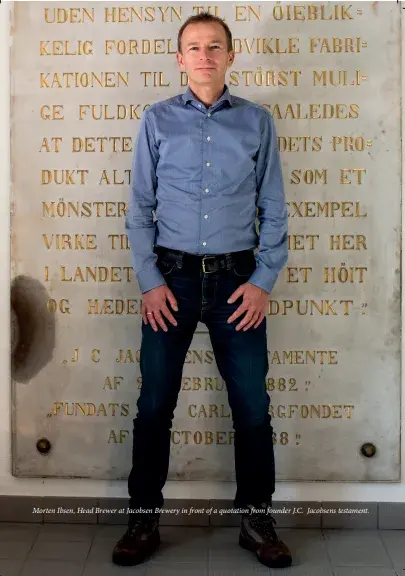
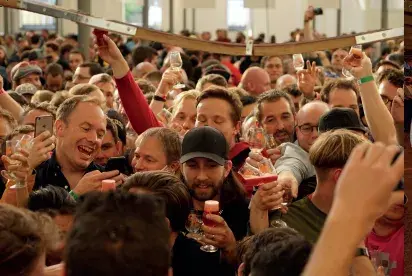
In 2012 Mikkeller created an international beer festival attracting thousands of foreign guests and dozens of foreign cult beer producers to an event for hard core beer nerds.
With know-how from Carlsberg and fresh inspiration from craft beer circles, Jacobsen became a successful supplier of craft beer in a more civilized form. It is not the type you will find on tap at the most ambitious beer bars, but the brand with its 20 or so varieties has a strong following and is popular with many smørrebrød restaurants. It is definitely a success, but Jacobsen has in no way cannibalized its parent. The Grøn Tuborg Pilsner remained the most popular beer, outselling its fancy little brother 10,000 times in Denmark and 1,000,000 times by Carlsberg Groups international sales of beer. But the Jacobsen Brewery is not about size, says Head Brewer Morten Ibsen.
‘At Jacobsen we combine science, tradition and passion into what I like to call the art of brewing, and we are becoming ever more experimental as the years pass, working with still smaller batches in order to be more creative and flexible,’ says Morten Ibsen.
Several of the other microbreweries went bankrupt in the 2000s while others were succesful, but none found success on the scale of Mikkeller, a brewery co-founded in 2006 and run by the young schoolteacher Mikkel Borg Bjergsø.
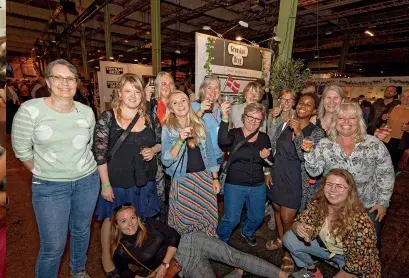
Since 1998 the association Danish Beer Enthusiasts have arranged a yearly beer festival attracting large crowds of Danes not necessarily beer geeks, just ordinary citizens with a healthy thirst for beer.
In a way, Bjergsø actually followed in the footsteps of Carl Jacobsen, who started his career as a ‘rental brewer’ paying established brewers for use of their equipment. Mikkel Borg Bjergsø did exactly the same. He became famous as a ‘nomad brewer’ who did not own any production facilities but nevertheless became world-famous in beer circles. From the beginning of his business career, most of his production took place outside of Denmark, and it is also internationally that most of Mikkeller’s fame and fortune has been made. The brewery stood out from the other microbreweries by introducing very unusual and daring beers. This created a profile that separated Mikkeller beer from the the rest of the beer universe
Up until Mikkeller’s entry in the market, the majority of beer enthusiasts were men who felt at home in the old-fashioned pubs and taverns. Mikkeller connected with the young hipster movement and managed to lend an air of funky hipness to beer’s previously dusty and stale image. This helped establish a niche for beer connoisseurs similar to the one for wine connoisseurs, but with the important difference that beer is more accessible.
Mikkeller quickly became a very successful and profitable business that today produces more than 5 million litres of beer yearly and runs a brewery in the United States, two in Denmark

and one in Britain. Their beer is sold in more than 50 countries, among others by Mikkeller’s own bars and restaurants in more than 40 locations worldwide, albeit the headquarters and its 35 employees remain in Denmark. Mikkeller inspired many of the young brewers who set up shop in the last ten years. And while the first wave of microbreweries in the 1990-00s was fiercely competitive, the next generation seem to enjoy a greater amount of cooperation and mutual support.
‘In the early days, when I started out, I felt it was very much an ‘us against them’ situation, whereas today the breweries cooperate much more, and the scene is much more interesting right now,’ says Mikkel Borg Bjergsø, who welcomes the competition with open arms.
‘To be honest, I wondered – for many years – why nobody stood up and competed with Mikkeller. Since 2006 when we launched and until 2015, there were almost no challenger. But then things started to change with guys like Gamma Brewing and Åben, who impresses me with talented branding,’ says Bjergsø.
One of Gamma Brewings three founders is Jakob Nørby Houmøller. He confirms Mikkel Borg Bjergsø’s impression of a beer scene that is inclusive, and in some ways similar to Denmarks gastronomic revolution in the 1990-2000s. Here young chefs changed the landscape of gastronomy, transforming an environment of fierce competition among chefs and restaurants to one in which cooperation and knowledge sharing reigned.
‘I don’t see the other breweries as competitors. We all have the same goal; make people drink better beer, and making great beer is what occupies our minds. When my partners and I started out, we received all the help we needed from other brewers, all you had to do was ask, then somebody would help you,’ says Jakob Houmøller.
Since its start in 2015, Gamma Brewing has been located in a defunct dairy, where several independent brewers have their own tanks lined up. But thanks to rapid growth, Gamma is breaking away, and will soon move into a brand new 1.5 million euro brewery, which is a symbol of the young brewery’s financial success. Gamma has been a profitable venture from the start, and even though the beer is sold at the markets highest prices, consumers are happy to pay the premium price since the product is out of the ordinary.
Before they launched their own place, the three partners worked as bartenders in various beer bars, Denmark is blessed with lots of such specialized beer bars offering lots of variety, as well as several eateries where beer and food are paired. Of course, this is also the definition of a smørrebrød restaurant, but in the case of brewpubs like Warpigs and Nørrebro Bryghus in Copenhagen, smørrebrød is not the focus.

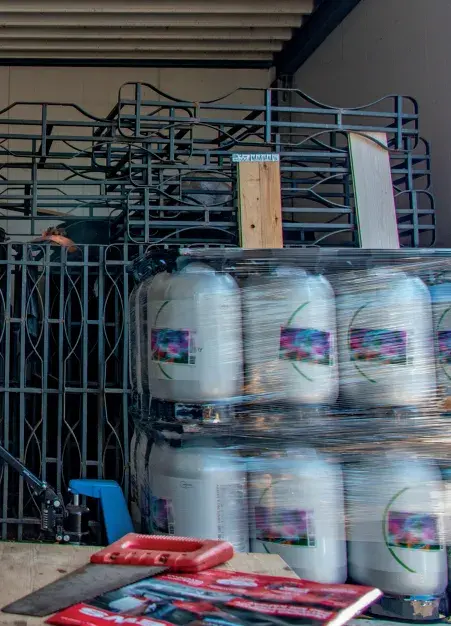
Copenhagen and other Danish cities host several annual beer festivals. In 2001, as mentioned earlier, Danske Ølentusiaster founded the Ølfestival, or ‘Beer Festival’, where thousands of guests could taste hundreds of speciality beers. Each year, the event’s popularity grew, the latest version in 2019 attracted 14,000 visitors who could sample more than 1,000 different beers from more than 200 breweries.
Mikkeller launched, in 2012, a festival called Beer Celebration that concentrated on craft beers from around the world. This grew into a successful event attracting mostly international visitors eager to taste some of the world’s most sought-after craft beers. From the beginning has not been on Danish beer: most of the breweries represented are foreign, attracted by Mikkeller’s worldwide fame.
In 2020, a new festival with broader appeal was launched alongside the Mikkeller Beer Celebration. Called Copenhagen Beer Week, it is arranged by the Food Organisation of Denmark in cooperation with more than 30 Danish breweries. This collaboration displays the diversity of the Danish craft beer scene, which has never been stronger.
The count of breweries reached 216 in 2020, exactly 100 more than a decade ago and more than 200 more than in the year 2000. The number of private hobby brewers is estimated to be around 5,000 out of Denmarks population of 6 mio., so it is safe to say, thet the Danes have preserved their historic thirst for beer.
